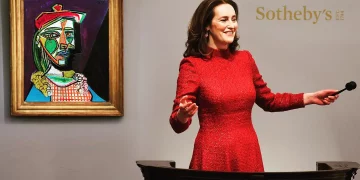In recent years, a curious trend has emerged in the world of high-profile exhibitions. Items once owned by disgraced celebrities, whose actions have led to their fall from grace, are finding a new life in museum displays and auctions. From personal memorabilia to fashion, art, and luxury items, these controversial collections are being presented to the public, often commanding high prices and attracting significant attention. But why are these once-discarded possessions now gaining popularity in the collector’s market? The answer lies in a complex interplay of fame, scandal, and the rise of what can only be described as the “cancellation premium.”
In this article, we will examine the emergence of disgraced celebrities’ collections as exhibition stars, the factors driving their newfound appeal, and the ethical questions surrounding their display. We will also delve into the phenomenon of the “cancellation premium”—a term used to describe the surge in value and interest surrounding items associated with celebrities who have been embroiled in public scandals. Finally, we will explore the implications of this trend on the art, fashion, and collectibles markets, and what it reveals about society’s relationship with fame, shame, and memory.
The Rise of Disgraced Celebrities’ Collections
It may seem counterintuitive, but items associated with celebrities who have fallen from grace are being featured in exhibitions and sold for large sums at auctions. Once considered toxic or undesirable due to the negative associations with their former owners, these collections are now seen as valuable commodities. What explains this shift in attitude?
One of the key factors is the inherent fascination with celebrities. Throughout history, society has been captivated by the lives of the rich and famous, and this obsession has only intensified with the rise of social media, reality television, and 24-hour news cycles. A celebrity’s personal possessions—whether it’s a luxurious designer item, an iconic outfit, or a piece of art—become extensions of their persona. When these same celebrities become embroiled in scandals, their personal items often take on an added layer of intrigue. These items are no longer just objects; they are symbols of fame, excess, and, ultimately, downfall.
In some cases, the exhibition of such items can be seen as a form of public reckoning. By putting these items on display, museums and auction houses invite the public to examine the fallout from these celebrities’ controversial actions, forcing us to confront the intersection of fame, power, and morality. What once might have been considered taboo or unsellable becomes a spectacle, drawing visitors and collectors eager to engage with the celebrity’s legacy—however tarnished it may be.
The “Cancellation Premium”: A New Market Trend
One of the most fascinating aspects of the rise of disgraced celebrities’ collections is the so-called “cancellation premium.” This term refers to the phenomenon whereby items once owned by celebrities who have been publicly shamed, canceled, or disgraced suddenly see their market value increase. Instead of diminishing in worth, these possessions—ranging from fashion items and memorabilia to art and personal artifacts—often fetch higher prices than they did when the celebrity was in their prime.
At first glance, this may seem like a paradox. After all, a celebrity’s fall from grace is typically accompanied by widespread public condemnation. Shouldn’t their possessions be seen as tainted, unappealing, or even worthless? The opposite appears to be true, however. A number of factors contribute to this surprising trend.
The Appeal of Scandal
One explanation for the “cancellation premium” is the appeal of scandal itself. In our celebrity-driven culture, scandals often generate as much—if not more—attention than the achievements that made the individual famous in the first place. Scandal becomes part of the celebrity’s narrative, and their items take on a new, more controversial allure. Collectors and exhibitors alike are drawn to these objects because they now tell a more complex, compelling story. The items associated with these celebrities are no longer just markers of success—they are reminders of how the individual’s fame unraveled, how they lost their public standing, and the way the public’s perceptions shifted.
The fascination with scandal and downfall is nothing new. We have seen throughout history that societies often take a morbid interest in the rise and fall of their idols. From ancient Rome to modern-day Hollywood, the narrative of a celebrity’s fall from grace has always captured public attention. Now, with the advent of social media and the increasing prominence of “cancel culture,” the fascination with a celebrity’s misdeeds is amplified. Items that were once part of an untouchable, polished image now become repositories of a darker, more dramatic story.
The Nostalgia Factor
Another reason for the growing interest in these collections is nostalgia. For some collectors, the items once owned by celebrities represent a bygone era—a time when the individual was still at the height of their fame. For those who admired the celebrity in their prime, owning a piece of their past can evoke powerful emotions. In a way, these items become a connection to the golden age of the celebrity’s career, even though that time has been overshadowed by scandal.
As much as scandal can tarnish a celebrity’s reputation, nostalgia can often counterbalance that negativity. Collectors and fans who grew up idolizing a particular celebrity may still feel a sentimental attachment to their work, even if they are now repulsed by their actions. In this sense, the items associated with the celebrity become relics of a former time—a time when the individual was untouchable, before the scandal.
The “Forbidden Fruit” Effect
There’s also a psychological factor at play. The “forbidden fruit” effect refers to the idea that people are often more drawn to something when they are told they cannot have it or when it becomes controversial. The concept of a celebrity’s possessions becoming “off-limits” or “tainted” can heighten their appeal to certain buyers. People are often intrigued by what is considered taboo, and as a result, these items become more desirable.
This phenomenon is particularly strong in the world of collectibles and luxury items, where rarity and exclusivity already drive demand. When a celebrity’s personal belongings are removed from the public sphere and shrouded in scandal, they become symbols of something forbidden, something that is no longer readily available. This, in turn, can drive up their market value.

The Ethics of Displaying Disgraced Celebrities’ Possessions
While the rising interest in disgraced celebrities’ collections is undeniable, it raises a number of ethical questions. Is it appropriate to celebrate the possessions of individuals who have caused harm or committed immoral acts? Should we continue to elevate the legacy of celebrities who have been disgraced, or should their actions disqualify them from such attention?
The Moral Dilemma
One of the central ethical concerns revolves around the question of whether we should continue to admire and celebrate individuals who have caused harm. The answer depends largely on one’s view of celebrity culture and the role of public figures in society. On one hand, celebrities are often seen as larger-than-life figures whose actions can have a far-reaching impact on public perceptions of morality and ethics. When they falter, they are often viewed as cautionary tales. On the other hand, the public’s fascination with these figures, even after their disgrace, raises questions about whether society is truly invested in holding them accountable.
Some argue that displaying and auctioning the items of disgraced celebrities serves to dehumanize them, reducing them to their possessions rather than the complex individuals they were. It also raises the issue of whether the public’s desire to own these items reinforces a culture that profits from scandal rather than condemning it.
The Market’s Role in Shaping Legacy
The marketplace plays a significant role in shaping the public’s perception of celebrities, even after they’ve been disgraced. By continuing to display and sell the items of celebrities who have fallen from grace, auction houses and museums may inadvertently contribute to the commodification of scandal. They may turn the celebrity’s fall into a profitable business model, which can feel morally questionable. After all, the very items that were once symbols of the celebrity’s rise to power are now objects of fascination, despite the harm the celebrity may have caused.
At the same time, others argue that the items themselves are neutral—it’s the context in which they are displayed that matters. These items, whether they are fashion pieces, artwork, or personal belongings, have intrinsic value as artifacts of culture, history, and design. In this sense, the scandalous nature of their former owner might not negate their artistic or historical significance.
Conclusion: A New Age of Celebrity, Fame, and Scandal
The phenomenon of disgraced celebrities’ collections becoming exhibition stars is a reflection of our complex relationship with fame and scandal. These items, once tainted by their association with their controversial owners, have found a new life in the world of art, fashion, and collectibles. The market for these possessions is driven by a mix of fascination, nostalgia, and the allure of the forbidden. While the “cancellation premium” may continue to rise, the ethical questions surrounding the display of these items remain unresolved.
Ultimately, the rise of these collections reflects the shifting dynamics of celebrity culture in the age of social media and cancel culture. As the public continues to grapple with the consequences of celebrity misdeeds, the market for their possessions will likely remain a battleground where fame, shame, and profit intersect in intriguing and often morally ambiguous ways.

















































